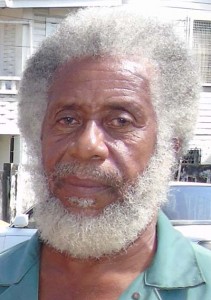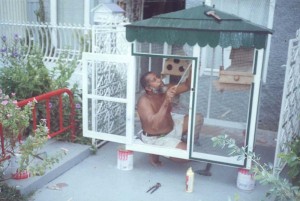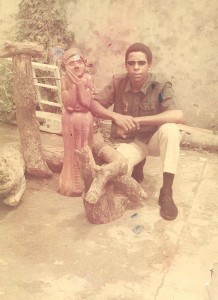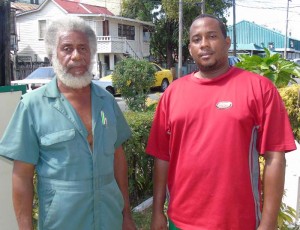Latest update February 7th, 2025 2:57 PM
Latest News
- AFC Leader Nigel Hughes welcomes any investigation into lands he acquired
- Pres. Ali defends Jagdeo’s attacks on critics
- VP Jagdeo tries to compare 75 acres of jungle lands Nigel Hughes wants to acquire with 35 acres of prime city lands sold to Ed Ahmad and others
- Greaves tells Govt ‘clean money’ used to acquire New York properties- Jagdeo
- Trump says Israel would hand Gaza to the US after fighting is over
Veteran artisan Michael ‘Saw man’ Trotman is a ‘Special Person’
Feb 28, 2016 News
“It started from seeing my mother. I always say children can really be influenced by what they see. I started tinkering with paper and lead pencil, reading comic books, and later on the dream (of producing craftwork). But school was involved also. In those days you had to do Industrial Arts.”
By Jarryl Bryan
Michael Trotman, better known by the moniker ‘Saw man’, has been a driving force within the local craft and
arts industry. A student and protégé of legendary sculptor Philip Moore, Trotman reflects on having experienced colonial, independent, violent and despotic Guyana, to eventually witness what many see as Georgetown’s renaissance.
‘IT STARTED FROM SEEING MY MOTHER’
Born on August 16, 1948 to Stella Trotman and Fraser Clark, a Bajan and a policeman, Michael Trotman grew up in the city. Noting that he was always curious about making things, Trotman was a prodigious child who started fiddling with technical drawings. He was also encouraged by his mother, herself an artisan, whom he would sit and watch as she worked.
“It started from seeing my mother. I always say children can really be influenced by what they see. I started tinkering with paper and lead pencil, reading comic books, and later on the dream. But school was involved also. In those days you had to do Industrial Arts. The boys were chosen based on their skill in the class room.”
Trotman attended Kingston Methodist School and Handicraft Centre, where he began his formal education specializing in Industrial Arts, aged just 11.
“We were exposed to metalwork and woodwork. After two years we were permitted to go on the machines they had there, like the band saw.”
He noted that they also did work on the lathe.
Armed with this knowledge, Trotman said when they left school at primary level they could have gone on to the Government Technical Institute.
He emphasised that to gain access to such dangerous machines was no easy feat. A student had to have been doing Industrial Arts for two years, and proven their competency, to earn that trust.
MEETING PHILIP MOORE
It was while attending Primary School that Trotman came into contact with sculptor Philip Moore, whose most recognisable work is the 1763 Monument at the Square of the Revolution.
At the time, already one of the most celebrated artists among his contemporaries, Moore operated the Helen Tait Ballerina School on Murray Street. Trotman as a young child would go there and do many wood carvings.
While Moore lived in Thomas Street, Trotman did not live far away, and it was easy for him to maintain contact. As he grew older, he would continue his wood carvings under Moore’s guidance.
Trotman reflected that Phillip Moore was no mere artist, but would brainstorm and
inculcate poetry in his work as an inspiration. Notwithstanding his achievements, Trotman stated that his former mentor always remained humble and believed in letting the public share in his work for the inspiration it could provide.
“He was humble and he never hid his work,” Trotman related.
“He liked to carve when people were around and he would show them the details and explain what they were about.”
According to Trotman, Moore did not start his career with the kind of local cultural depictions that brought him the most recognition, but rather, with pieces whose subjects originated from Europe.
Speaking about Moore’s work on the 1763 Monument, Trotman recalled that there were some who were apprehensive about the sculpture because of its deep symbolic resonance. According to Trotman, they would have preferred something simpler. But Moore eschewed such thoughts and in time, Trotman would seek to highlight the symbolism in his work as well.
GOLDEN OPPORTUNITY
At the age of 16, Trotman did the College of Preceptors’ exams. He then moved on GTI.
In 1965, a golden opportunity presented itself, as the Government of the day prepared to receive a visit from Britain’s Queen Elizabeth II and her husband, the Duke of Edinburgh.
“There was a request from Fogarty’s Store Limited to the GTI principal at the time,
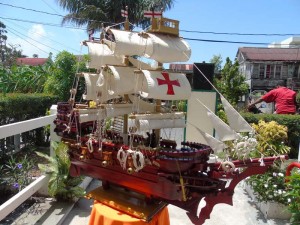
One of our Special Person’s more intricate creations, a 17th century slave ship, constructed with deep cultural features in every carving.
Compton Pooran, to have two ornate (portrait) frames made at the school. Original copies had to be made from those copies that were in England. And they wanted the exact duplicate.”
There was a small hitch, however. There were no carvers at GTI. Personally, Trotman had been pursuing a course entailing cabinet woodworking and joinery. However, his forays into art would swing opinion in his favour.
“I was doing art and they knew (this) from pieces of work I would take to school to show friends in the classroom,” Trotman related. “So they said ‘oh, you’re the person we will use to do the carving on the frames’. They asked me if I would undertake the carvings from the originals that were on the wall in parliament.”
He recalled that officials took him to public buildings to assess the carvings. Upon doing this, he realized how intricate the work really was. It was modelled after a floral pattern, but so finely carved that it could only have been done by machine.
“It was not done locally. But we had to do it, because it was more or less a commissioned work from William F. Fogarty’s, he was the chairman,” Trotman said. “There is a saying with the British that they only say well done, once. My lecturer, John Brown, was always stern on that. He was an Englishman and he always said, measure twice, cut once.”
Trotman did the sketching from the originals and also did practice runs. With a deadline
for February 1966 to meet, he started the work in mid-1965. Trotman related having to use dental equipment in order to sand, so delicate was the work.
“There were 16 panels to be completed, with three rows of wood carving,” the expert sawman related. “So I was really under pressure from the principal, the deputy principal and my class lecturer, Mr. Brown. I was 17 years of age.”
It was a challenge, because I had to represent Philip Moore at the time, because I was still under his charge. Plus a classroom with 17 young men… so you could imagine the heckling. So I really had to pull it off and I did.”
When completed, each frame carried eight pounds of wood carving. They were sprayed in a gold finish by his class instructor and then the product was finished. Everyone including Journalists and photographers then gathered curiously.
Trotman stated that after the frames he never looked back or doubted his skills, but was spurred on to more success. Leaving school, he went into self-employment.
STAYING ABOVE POLITICS
Trotman then briefly recalled the tumultuous period in the sixties, when there was unimaginable unrest and loss of lives. He was a young man, and the impact was profound. Amidst these upheavals, however, Trotman said that he stayed above politics and continued to produce his art. He would go on to do other commissioned works for influential figures.
One of these, almost two decades later, was a combination set which was presented to President Forbes Burnham for his 60th birthday. The work was commissioned by the Guyana National Industrial Corporation (GNIC). The gift had to be locally made rather than something imported. This would be a description of many of Burnham’s policies.
Once again, Trotman was under pressure to complete the work. However, when it was finished it had fulfilled its aesthetic and symbolic purposes. Its practical purpose was as a pen, letter and general holder. Made from several species of Kiln-dried wood, the work was also placed in a wooden box lined with purple silk, another creation of Trotman.
Again, Trotman did not go up to bask in any accolades for his work, an attitude he maintains is important for craftsmen to cultivate. He was, however, acknowledged for the quality of work in reviews by Burnham. The work itself was kept on his desk.
Today, however, the craftsman has no idea where this work is and believes it may have been lost with time.
MARRIAGE, OTHER INTERESTS AND LIFE TODAY
In 1976, Trotman met Lucille, a beautiful cashier and as his interest grew, so did his visits to the store at which she worked. They married in 1980 and the marriage produced three children; Michael Jr., Lucille and Vanessa. Michael Jr. has followed the path of craft making and is currently a lecturer attached to a Ministry of Public Health programme, helping the disabled to learn craft. while Trotman’s daughters have both pursued the culinary field.
Today, Trotman has not slowed up, but remains driven to make his contribution to arts and crafts. One of his most beautiful and symbolic pieces was in fact started two years ago, a collector’s item slave ship of the 17th century fitted with every detail such a ship would have, from cannons to the slaves themselves.
The ships natural wood was ‘kerotene silverballi’, with two-inch planks and sprayed a blood red colour rather than the usual brown, to denote the pain and suffering of the time.
“It is not a story of happiness,” Trotman related. “The bell, the lamp, the captain’s quarters, the maids, the stairwells, the cannons, the rope ladder to carry one up to the crow’s nest and the crow’s nest itself are (all) on the ship, (even) the anchor.”
He noted that the figurines at the bottom of the ship are to bring reality to the situation. The portrayal of female figurines detained and the figurines of muscular slaves standing defiant, but in reality still in chains, show the story of human suffering.
A tiny globe can also be seen on the ship. Its symbolism is clear, to reinforce the fact that back then wars were perpetuated on a global scale for the sake of lands or in this case, human cargo.
“It is a collector’s item or possibly a contribution to ACDA or the National Museum.”
Trotman now operates from home, where he has a woodworking shop that offers many services including joinery. As a concerned citizen, he pays keen attention to the clean-up efforts taking place around the city, as the country counts down to 50 years of independence. He is pleased with the transformation.
Trotman has fervent hopes that the event (observance of independence) can be used as a vehicle for change. He notes that his works and the works of other local craftsmen are intrinsically Guyanese, and can be used to promote local culture. He is thus eager that his trade gains prominence, and is even willing to give classes in the art, at no cost to the Government, as it will have social and economical benefits to youths.
For his status as a role model, his years of dedicated work, which has stayed unique and promotes the skilled side of local culture, and his desire to help the youths find their way to success, Michael ‘Saw man’ Trotman is undoubtedly a ‘Special Person.’
Share this:
- Click to print (Opens in new window)
- Click to email a link to a friend (Opens in new window)
- Click to share on Facebook (Opens in new window)
- Click to share on WhatsApp (Opens in new window)
- Click to share on Twitter (Opens in new window)
- Click to share on Pinterest (Opens in new window)
- Click to share on Pocket (Opens in new window)
- Click to share on Tumblr (Opens in new window)
- Click to share on Reddit (Opens in new window)
- Click to share on LinkedIn (Opens in new window)
Related
Similar Articles

The Glenn Lall Show | February, 3rd, 2025
Follow on Tik Tok @Glennlall
THE BLUNT OF THE DAY

Sports
Feb 07, 2025
2025 CWI Regional 4-Day Championships Round 2…GHE vs. CCC Day 2 -Eagles (1st innings 166-6, Imlach 58*) trail CCC by 209 runs Kaieteur Sports- Combined Campuses and Colleges (CCC) owned Day 2...Features/Columnists
What Guyanese leaders can learn from Donald Trump
Peeping Tom… Kaieteur News-There is little dispute that Donald Trump knows how to make an entrance. He does so without... more
OAS Secretary General Election and renewed OAS Consensus
Antiguan Barbudan Ambassador to the United States, Sir Ronald Sanders By Sir Ronald Sanders Kaieteur News- The upcoming election... more
Publisher’s Note
Freedom of speech is our core value at Kaieteur News. If the letter/e-mail you sent was not published, and you believe that its contents were not libellous, let us know, please contact us by phone or email.
Feel free to send us your comments and/or criticisms.
Contact: 624-6456; 225-8452; 225-8458; 225-8463; 225-8465; 225-8473 or 225-8491.
Or by Email: [email protected] / [email protected]
Weekend Cartoon




